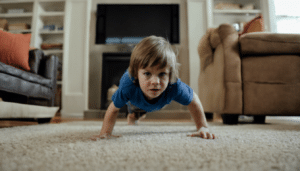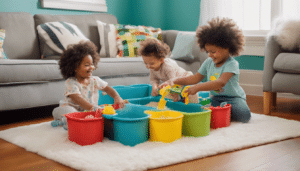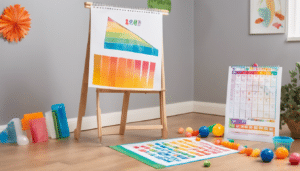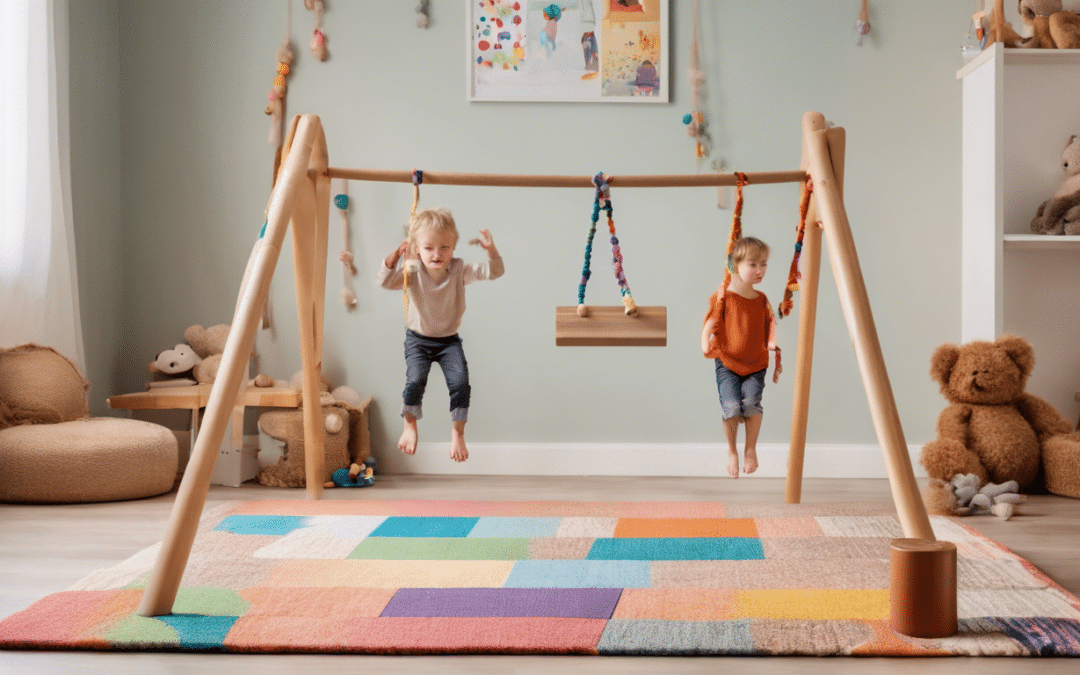Could the comfort of your home could be the perfect setting for sensory integration exercises? You’re likely seeking ways to support a loved one’s sensory needs, and you can create an effective, nurturing environment right where you are. By introducing sensory activities tailored to individual preferences and challenges, you’re setting the stage for significant improvements in sensory processing. Consider constructing a sensory space with items encouraging touch, movement, and balance or using everyday objects for proprioceptive input. You’ll find that incorporating deep-pressure activities or vestibular exercises into daily routines can make a world of difference. As you embark on this journey, remember to observe and adjust the exercises to fit the evolving needs of the individual you’re dedicated to helping.
Key Takeaways
- Sensory integration exercises at home can help individuals with sensory needs.
- Designing a sensory space with appropriate textures and lighting can enhance sensory experiences.
- Collaborating with therapists and teachers can provide personalized recommendations for sensory exercises.
- Engaging in proprioceptive input techniques, such as heavy work activities and muscle stretching exercises, can enhance sensory integration and body awareness.
Understanding Sensory Integration
Why do you sometimes feel overwhelmed by your senses and, at other times, barely notice them? This fluctuation is often due to your nervous system’s ability to process sensory information – a process known as sensory integration. Sensory integration is how your brain interprets and organizes sensory input, helping you respond appropriately to your environment.
When this process is functioning smoothly, you’re likely not even aware of the constant work your nervous system is doing. However, when there’s a hiccup in sensory integration, you might become overstimulated, leading to feelings of discomfort or even distress. Understanding sensory integration and its effects on behavior and emotions becomes crucial, mainly if you’re dedicated to serving others, including children with varied sensory needs.
Sensory corners, proprioceptive activities, and deep pressure exercises regulate sensory input. These activities aren’t just play; they’re therapeutic tools designed to help individuals find balance in their sensory experience. These activities can support a child’s nervous system integrate sensory information more effectively, improving focus, behavior, and emotional regulation.
Designing a Sensory Space

As you begin crafting your child’s sensory space, it’s crucial to consider the layout essentials that will foster both comfort and stimulation.
Selecting appropriate textures for items like rugs, blankets, and furniture covers can significantly influence your child’s sensory experience.
Paying attention to the lighting and color scheme will also play a pivotal role in creating a calming and conducive environment for sensory integration.
Space Layout Essentials
Your sensory space’s layout is crucial, incorporating multisensory experiences to cater to your child’s needs. Begin by selecting a corner that can offer safety and stimulation, using soft furnishings to create a comforting retreat. A big, comfy bean bag chair can provide deep pressure, promoting a calming effect.
Collaborate with therapists and teachers for a personalized touch, gathering feedback on the most beneficial features.
Include a sensory bin filled with various textures to engage tactile exploration. To support your child’s vestibular system, which is essential for balance, introduce activities like trampolines or gentle rocking while held securely by you.
Whether it’s a secluded tent or an open area, ensure the space reflects your child’s preferences and therapeutic recommendations.
Choosing Appropriate Textures
Selecting the right textures for your home’s sensory space can significantly enhance your child’s tactile experiences and promote sensory integration. Different textures stimulate the sense of touch, which is crucial in sensory integration activities. Here’s how you can choose:
- Soft Furnishings: Utilize plush fabrics or faux fur for cozy, calming areas.
- Tactile Activities: Introduce sand, playdough, and other varied materials for hands-on exploration.
- Deep Pressure: A bean bag chair can offer comforting pressure and stability.
- Discovery: Encourage curiosity with a mystery box filled with assorted texture items.
Lighting and Color Impact
Moving from tactile elements to the ambiance of your sensory space, carefully chosen lighting and colors can profoundly influence mood and sensory responses. Soft, natural lighting often creates a calming atmosphere, which is essential for easily overstimulated children. It’s about striking a balance that enhances visual perception without overwhelming sensory stimulation.
Warm and neutral colors tend to be soothing, providing a gentle environment that can help to stabilize emotions.
For children who might be under-responsive, consider incorporating areas with brighter colors to encourage alertness and engagement. Adjustable lighting is also crucial, allowing you to tailor the environment to suit different activities and moods.
Proprioceptive Input Techniques

Considering various proprioceptive input techniques, you’ll find that incorporating simple exercises into your daily routine can significantly enhance sensory integration. Engaging in activities that provide this kind of input can help children feel more grounded and aware of their bodies, which is especially beneficial for those with sensory processing challenges.
Here are four effective proprioceptive input techniques to try at home:
- Heavy Work Activities: Encourage carrying grocery bags, pushing a laundry basket, or helping with yard work. These tasks involve lifting, testing, and pulling, offering valuable sensory feedback.
- Therapeutic Climbing: Set up opportunities for climbing a ladder, rock wall, or monkey bars. This improves motor skills and provides the necessary input to help the child’s sensory system integrate.
- Muscle Stretching: Engage in passive activities like stretching or yoga poses. These exercises help the child to feel their muscles extending and contracting, promoting a sense of calmness.
- Warm Pressure: Using weighted blankets or holding warm objects can deliver gentle but firm proprioceptive input, helping to soothe and regulate the child’s sensory experience.
Deep Pressure Therapy Activities
As you explore deep pressure therapy activities at home, you’ll find that weighted blankets offer a comforting, enveloping sensation that can significantly soothe sensory overload.
Incorporating compression clothing into your child’s routine can provide constant pressure and may even help with body awareness and calming.
Creating homemade sensory tools, such as weighted lap pads, can also be an affordable and personalized way to achieve deep pressure input.
Weighted Blanket Use
You can use a weighted blanket to provide soothing deep pressure, aiding sensory regulation and promoting security. This sensory integration activity harnesses passive proprioceptive input to help calm and center children who may feel overwhelmed.
Here are four key ways to incorporate weighted blankets into your routines:
- During Quiet Time: Encourage the child to use the weighted blanket while reading or resting, helping to transition into a peaceful state.
- At Bedtime: Implement the blanket as part of the bedtime ritual to improve sleep quality.
- In the Sensory Corner: Make the weighted blanket accessible in a designated calm space for self-regulation.
- While Traveling: Bring a portable weighted lap pad for comfort during car rides or flights.
Compression Clothing Benefits
Incorporate compression clothing into your child’s home routine to harness the calming benefits of deep pressure therapy. These snug garments, including armchairs and vests, offer a sense of security that can be profoundly soothing for children with sensory processing issues. You’re not just providing comfort as you gently guide your little one into a weighted vest or under a compression blanket. You’re actively participating in an occupational therapy-recommended practice that can help regulate emotions and behaviors.
Utilizing deep-pressure activities such as these promotes a therapeutic environment right at home. It’s a systematic approach that supports your child’s development, providing passive proprioceptive input even during quiet moments of reading or relaxation.
Homemade Sensory Tools
With items around your house, you can create practical deep-pressure therapy tools that nurture your child’s sensory needs. These homemade sensory tools can provide sensory input to help your child feel grounded and secure.
Here are a few ideas to get you started:
- Transform a bean bag chair into a cozy retreat with a hugging sensation.
- Set up a tent or wigwam as a personal space that can be adapted for seclusion or openness.
- Use a stack of pillows to apply gentle, calming pressure on your child as they relax on a mat.
- Repurpose a snug kiddie armchair and a handheld massager to deliver snugness and vibration for deep pressure input.
Vestibular Stimulation Methods

Explore various vestibular stimulation methods at home to support your child’s sensory development and integration needs. These activities are designed to engage the inner ear, which plays a critical role in helping the body understand and process movement. Implementing these sensory integration exercises can be stimulating and calming for children, particularly those with unique sensory needs.
Incorporate gentle bouncing on a trampoline, allowing your child to lie or sit while experiencing the motion. This can be a delightful way for them to receive vestibular input in a controlled environment.
A low swing offers soothing back-and-forth motion—guiding them to swing comfortably and ensuring security throughout the activity.
Rocking on a rocking horse is another method that provides rhythmic, repetitive movement beneficial for sensory regulation. The key to these activities is observing your child’s responses and offering encouragement without pressure. Children who are fearful or hesitant should never be forced to participate.
Regularly engaging in these vestibular stimulation methods can significantly aid children with sensory processing difficulties, promoting better emotion and behavior regulation. Remember, gentle guidance and observation are paramount to creating a positive and supportive experience during these exercises.
Oral-Motor Exercise Ideas

You can improve your child’s oral-motor skills during home sensory integration by blowing bubbles or sipping thick liquids through a straw. These oral-motor exercise ideas aren’t only enjoyable and strengthen motor skills crucial for speech development, eating, and overall sensory regulation.
Here are a few practical exercises to consider:
- Blowing Bubbles: Have your child blow bubbles in water using a straw. This helps enhance breath control and lip rounding.
- Sipping Thick Liquids: Offer your child a thick milkshake or yogurt to sip through a straw. The effort required to draw up the liquid strengthens the mouth muscles.
- Playing Harmonicas: Encourage your child to blow on harmonicas or other wind instruments, which promotes coordination and control of mouth movements.
- Chewelry and Chew Tools: Consult a therapist for suitable chew tools your child can use safely. These tools can provide proprioceptive input and help prevent chewing on inappropriate objects.
Always supervise your child during these activities and maintain proper oral hygiene. With time and practice, these exercises can significantly improve your child’s oral-motor abilities.
Tactile Sensory Play

Tactile exploration is essential for your child’s sensory development, and incorporating sensory play into your home routine can be fun and educational. Engaging in tactile sensory play allows your child to process sensory information in a way that can enhance their understanding of the world. It’s a nurturing process that invites children to explore, create, and learn.
Let’s delve into some activities that provide rich tactile experiences. You can create a sensory bin filled with various objects for your child to discover. Imagine the joy and surprise as they feel the differences between smooth pebbles, squishy sponges, and grainy rice. It’s an adventure in their own home!
Homemade playdough is another fantastic tactile tool. It’s not just about squishing and shaping; as your child kneads and rolls the dough, they hone fine motor skills and emotional regulation. Following the recipe together enhances their ability to process instructions and engage in a shared task.
Here’s a simple table to inspire your tactile sensory play at home:
| Activity | Benefits |
|---|---|
| Sensory Bin Exploration | Enhances visual perception and language skills |
| Homemade Playdough | Develops creativity and fine motor skills |
| Texture Guessing Game | Promotes sensory integration and tactile discrimination |
Visual and Auditory Exercises

As you explore sensory integration exercises to support your child at home, visual and auditory activities can play a pivotal role.
You can engage your child with flashlight focus games to sharpen their visual tracking, while music-listening activities may enhance their auditory processing.
Introducing color identification challenges adds a playful element but also aids in distinguishing and recognizing different visual stimuli.
Flashlight Focus Games
You can play fun focus games with a simple flashlight that sharpens your visual and auditory processing skills. These sensory integration activities aren’t only practical but can also be tailored to the individual’s needs, helping them develop visual and auditory coordination.
Here’s how to incorporate these games at home:
- Flashlight Tag: Move the light across a wall and have your child follow it with their eyes.
- Sound and Seek: Play sounds in different corners and use the flashlight to find the source.
- Color Hunt: Shine the light on objects of specific colors and ask your child to identify them.
- Rhythm Light: Flash the light in rhythm with music or clap for your child to synchronize their movements.
These exercises are an empathetic approach to enhancing focus and sensory processing in a caring, supportive environment.
Music Listening Activities
After exploring the dynamic world of flashlight focus games, you’ll find that incorporating music into sensory exercises can significantly enhance auditory and visual processing skills. Music listening activities stimulate the vestibular system and promote sensory integration, which is particularly beneficial for children with a sensory processing disorder. Combining music with movement, such as gentle bouncing or rocking, creates a multisensory experience that supports self-regulation and attention.
Introducing music in sensory corners can be calming, helping to reorganize emotions and behavior for overstimulated people. Additionally, pairing music with tactile experiences like playing instruments or exploring textures enables children to adapt to various sensory inputs, fostering their overall development methodically and empathetically.
Color Identification Challenges
Building on synchronizing sensory experiences, you’ll discover that color identification exercises can sharpen your child’s visual and auditory discrimination skills. These sensory integration activities aren’t only fun and crucial for their development.
Here’s how you can introduce color identification challenges:
- Start Simple: Begin with primary colors using toys and clothes to create a visual and auditory connection.
- Create a Game: Turn color identification into a playful activity, like a scavenger hunt for certain colored items.
- Gradual Complexity: Slowly introduce a broader range of colors to expand their sensory experiences.
- Integrate Daily: Incorporate color challenges into daily routines, making it a fun and educational part of their day.
Through these systematic steps, you’re not just playing; you’re providing essential growth opportunities for your child’s sensory processing abilities.
Incorporating Daily Routines

As you weave sensory integration exercises into your daily routines, you’ll find that simple tasks can be transformed into therapeutic opportunities. Creating a sensory corner with soft furnishings and a big comfy bean bag chair offers a go-to spot for calming and deep pressure input throughout the day.
Incorporating proprioceptive activities like pushing a trolley or carrying grocery bags helps with body awareness and strength. These tasks aren’t just chores; they’re a means to enrich your child’s sensory experience.
Movement activities such as gentle bouncing on a trampoline or rocking on a rocking horse can seamlessly integrate into playtime, stimulating your child’s vestibular system and promoting balance.
Here’s a table to help you visualize the integration of these activities into daily life:
| Daily Routine | Sensory Integration Activity |
|---|---|
| Playtime | Bounce on a trampoline |
| Chores | Carry grocery bags |
| Relaxing | Use a bean bag for pressure |
Your empathy and desire to serve shine through as you methodically incorporate these sensory-rich experiences, ensuring your child engages in meaningful activities that support their development. Remember, each small step contributes to their overall well-being.
Tracking Progress and Adaptation

To gauge your child’s development in sensory integration, you’ll need to regularly check in on their progress and tweak the exercises as necessary. This thoughtful observation and adjustment will support their growth and ensure the activities remain beneficial and engaging.
Here are four essential steps to help you track progress and adapt the exercises:
- Consult with Professionals: Keep in touch with therapists and teachers to discuss your child’s sensory integration journey. Their insights are invaluable in assessing effectiveness and making necessary adjustments.
- Personalize the Sensory Space: Pay attention to how your child interacts with their sensory corner. Modify elements to cater to their needs and preferences, ensuring a supportive environment.
- Monitor Deep Pressure Responses: Observe your child’s reaction to deep-pressure activities. Adjust the intensity and duration to find the most comforting approach for them.
- Evaluate Vestibular and Oral-Motor Activities: Observe whether vestibular exercises are calming or stimulating, and consult with therapists to provide the right oral-motor tools and techniques.
Your active role in tracking progress and adapting sensory integration exercises will foster a nurturing atmosphere that empowers your child to thrive.
Frequently Asked Questions
How Can I Do Sensory Integration at Home?
You can create a sensory-friendly space with soft pillows, engage in muscle-strengthening activities, offer deep pressure with blankets, and provide tactile experiences with materials like playdough for your child’s sensory integration at home.
What Are the Sensory Integration Exercises That Reduce Sensory Sensitivity?
Nearly 1 in 20 children experience sensory sensitivities. Exercises like heavy work activities, deep pressure techniques, and vestibular movements can significantly lessen these sensitivities, fostering a more comfortable and manageable daily experience.
What Is Sensory Integration Activities?
Sensory integration activities help you regulate your sensory input, enhancing your ability to process and respond to the environment effectively, especially if you experience sensory processing challenges.
How Can I Help My Child With SPD at Home?
To support your child with SPD, establish a sensory-safe zone at home, incorporate proprioceptive activities like jumping or pushing, and offer calming tools such as weighted blankets or oral-motor aids like chewy tubes.
Conclusion
Sensory integration activities can help children with autism develop essential skills like coordination, body awareness, and emotional regulation. These activities involve providing sensory input to the senses through items like balls, trampolines, chairs, pillows, and swings. Proprioceptive input can be provided through heavy work activities, like carrying laundry baskets or doing household chores. Deep pressure input can be provided through pillow fights or body socks. Finger painting and sensory walks can provide tactile experiences.
Children with autism can also benefit from physical movement activities like mini trampolines or resistance activities. Sensory integration techniques can also involve perceptual and auditory processing skills, like playing musical instruments or walking on a sensory path.
It’s important to provide sensory experiences regularly to help regulate arousal levels and prevent sensory overload. Depending on the child’s preferences, parents and therapists can create a fun environment with a ball pit, lava lamps, or bright lights. Chewy and crunchy foods can also provide sensory stimulation.
Regular exercise and play can help children develop motor, cognitive, and social skills through social interactions. Sensory integration therapy can be an exciting experience for children with autism and can help them regulate their emotions and improve spatial awareness. With hundreds of children with autism experiencing different sensory processing challenges, it’s essential to tailor the sensory activities to each child’s needs and developmental milestones.


Recent Comments